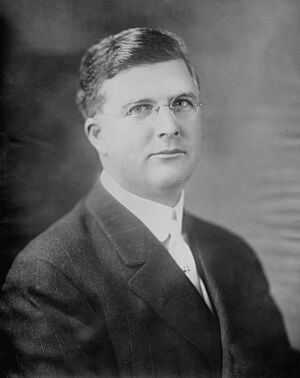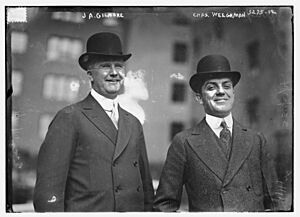James A. Gilmore facts for kids
Quick facts for kids
James A. Gilmore
|
|
|---|---|

Gilmore in 1914
|
|
| Born | March 2, 1876 Portsmouth, Ohio, U.S.
|
| Died | March 19, 1947 (aged 71) Waukegan, Illinois, U.S.
|
| Known for | President of the Federal League |
| Military career | |
| Service/ |
United States Army |
| Years of service | 1898–1902, 1918 |
| Rank | Sergeant |
| Conflicts | |
James Alexander Gilmore (March 2, 1876 – March 19, 1947) was an American businessman. He led the Federal League, a baseball league that tried to become a third major league. This happened in 1914 and 1915, alongside the American League and National League.
Early Life and Work
James Alexander Gilmore was born on March 2, 1876, in Portsmouth, Ohio. He had three brothers and one sister. In 1882, his family moved to St. Louis, Missouri, and then to Chicago, Illinois. His father worked for a department store called Carson Pirie Scott & Co.
Gilmore went to school on Chicago's West Side. He enjoyed playing baseball in empty lots and also played as a semi-professional. This means he played for money, but not as a full-time job.
After school, Gilmore worked as a messenger for Armour and Company, a meatpacking company. He earned $3 a week. When he asked for a raise to $4, he didn't get it. So, he joined his brother at a coal company, earning $7 a week.
Military Service
When the Spanish–American War started, Gilmore joined the United States Army. He was sent to Cuba with the 1st Infantry Regiment. He became very sick with a fever and lost a lot of weight. It took him 13 months to get better.
He then volunteered for the Philippine–American War. He went to the Philippines with the 43rd Infantry Division. In 1900, he became a sergeant. He served in the Philippines for almost two years.
After returning from the war, Gilmore worked as a coal salesman. He worked for different companies and moved up in his career. By 1910, he became the president of a manufacturing company.
Baseball Career

In 1913, Gilmore played golf with friends who were investors in the Chicago Whales. This team was part of the Federal League. This league was new and not part of the main baseball system called "Organized Baseball."
Gilmore decided to invest in the team himself. He and his friends put in $12,000, which helped him take control of the team. In August 1913, Gilmore became the acting president of the Federal League. He was officially elected president in November.
By the end of the 1913 season, most Federal League teams were losing money. Gilmore believed there was room for a third major baseball league. The American League and National League were the only two major leagues at the time.
After the 1913 season, Gilmore convinced wealthy business people to become team owners. One of them was Charles Weeghman, who took over the Chicago team. Gilmore then reorganized the league, making it bigger from six to eight teams.
The Federal League started signing famous players from the National and American leagues, like Joe Tinker. Gilmore spent 1914 traveling to promote the league. He told people it would be a major league where teams were more evenly matched. After the 1914 season, Gilmore was chosen again as president for five more years.
However, team owners continued to lose money in both 1914 and 1915. After the 1915 season, the Federal League owners talked with the other major leagues. They agreed to close down the Federal League for $700,000.
Later Career and Personal Life
Gilmore joined the Army again in October 1918. He served in the Motor Transport Corps during World War I. After the war, he lived in New York City and worked as a stockbroker. He managed a brokerage firm until he retired in the 1930s.
Gilmore married Genevieve Williams in 1911. She had a daughter from a previous marriage. Gilmore and Genevieve did not have children together, and they divorced in 1916. In 1925, Gilmore married Electra Waggoner, but their marriage was ended a few months later.
Gilmore became sick in December 1945. He died on March 19, 1947, at Downey Veteran Administration Hospital.

